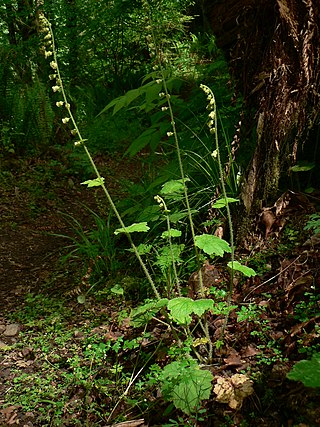Tellima
Genus of flowering plants in the family Saxifragaceae From Wikipedia, the free encyclopedia
Tellima grandiflora, the bigflower tellima[3] or fringecups, is a herbaceous perennial flowering plant in the family Saxifragaceae. It is the only species in the genus Tellima.[4][5]
| Tellima | |
|---|---|
 | |
| Scientific classification | |
| Kingdom: | Plantae |
| Clade: | Tracheophytes |
| Clade: | Angiosperms |
| Clade: | Eudicots |
| Order: | Saxifragales |
| Family: | Saxifragaceae |
| Genus: | Tellima R.Br. (1823) |
| Species: | T. grandiflora |
| Binomial name | |
| Tellima grandiflora | |
| Synonyms[2] | |
| |
Description
It has rounded stalked leaves mostly growing from the base emerging from a rootstock and bluntly toothed reaching heights of 30 cm.[6] It is evergreen in mild winters. Flowers are borne in spring and early summer, on spikes, terminal racemes, up to 60 cm high. The green calyx is 6–8 mm long; the five flower petals are greenish-white to purple, pinnately divided and spreading. The petals are deeply fringed. It has 10 stamens and 2 styles.[6]
Distribution
The plant is a native of moist forests in western North America, from Alaska and British Columbia to northern California.[7] It can be a garden escape and become naturalised in some other areas, e.g. Ireland and Great Britain. Although it is secure in the western portions of its range, Tellima grandiflora is listed as vulnerable in Idaho and Montana, and as critically imperiled in Alberta.[8]

Uses
It is widely grown in gardens. Different strains have been developed. It seeds itself freely in suitable climates.
This plant, crushed and made into an infusion, was used by the Skagit to aid people in sicknesses such as loss of appetite.[9] Ellagitannins are chemical compounds that have potential antiviral activity.[10] Tellimagrandin II, the first of the ellagitannins, formed from pentagalloyl glucose, is laccase-catalyzed dimerised to cornusiin E in T. grandiflora.[11]
References
External links
Wikiwand - on
Seamless Wikipedia browsing. On steroids.

